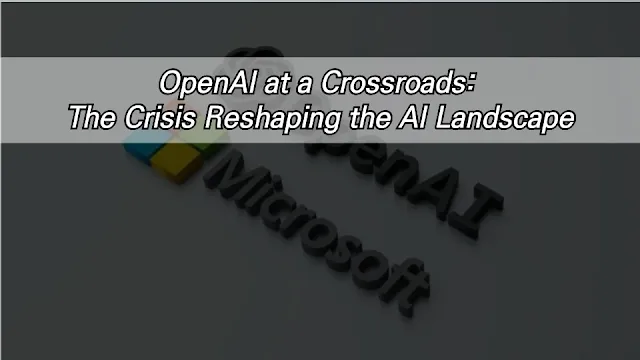The trajectory of OpenAI has long symbolized the promise and peril of artificial intelligence. In 2025, the company finds itself facing a convergence of challenges that threaten not only its leadership in the industry but also its organizational stability and strategic direction. What follows is a closer examination of the multifaceted crisis confronting OpenAI—one that reflects the complexities of the modern tech ecosystem.
The Microsoft Alliance: Strategic Asset or Structural Obstacle?
The partnership between OpenAI and Microsoft was once considered a model for collaboration between innovative startups and established tech giants. Microsoft’s substantial investment—totaling $13 billion—provided OpenAI with critical resources, including access to Azure’s computing infrastructure and a stable flow of capital. In return, Microsoft secured exclusive rights to OpenAI’s most advanced models and an influential stake in the company’s governance.
However, as OpenAI’s ambitions evolved, so did the dynamics of this relationship. OpenAI’s leadership, seeking greater flexibility and new sources of funding, initiated a transition toward a public-benefit corporation (PBC) structure. This move was intended to attract additional investment and lay the groundwork for a potential public offering. Yet, Microsoft’s contractual rights—such as its veto over major decisions and its special class of shares—have become significant barriers to this transition. The resulting impasse has escalated to the point where OpenAI is reportedly considering antitrust litigation against Microsoft, alleging that the tech giant’s control is stifling competition and innovation.
This standoff has already had concrete repercussions. A planned $30 billion investment, vital for OpenAI’s next phase of AI research and development, remains in limbo. The inability to resolve governance issues is not only delaying critical funding but also creating uncertainty for employees, partners, and the broader AI community. What was once a strategic asset has, in many respects, become a structural obstacle to OpenAI’s continued growth and independence.
Missed Opportunities: The Windsurf Acquisition and Its Aftermath
While OpenAI grappled with internal governance challenges, it faced another setback in the form of a failed acquisition. The company had identified Windsurf, a promising AI coding agent startup, as a key target to strengthen its technical capabilities. The deal, however, unraveled over concerns that Windsurf’s technology would ultimately be controlled by Microsoft, which operates a competing product in GitHub Copilot.
This hesitation proved costly. Google quickly capitalized on the situation, acquiring Windsurf’s core team and technology for $2.4 billion. The loss of Windsurf not only deprived OpenAI of valuable intellectual property but also exposed vulnerabilities in its decision-making process. In an industry where speed and alignment are critical, OpenAI’s internal divisions allowed a major competitor to gain ground.
The Windsurf episode serves as a broader warning: internal misalignment and protracted negotiations can translate directly into competitive disadvantage. As rivals like Google and Meta continue to pursue aggressive growth strategies, OpenAI’s ability to act decisively in the market is being called into question.
Talent Exodus and Intensifying Competition
Perhaps the most destabilizing aspect of OpenAI’s current crisis is the departure of key talent. Over the past several months, a significant number of engineers and researchers have left for competitors, most notably Meta and Google. These departures are not merely a matter of headcount; they represent a loss of institutional knowledge, technical expertise, and creative momentum.
At the same time, OpenAI’s competitors are advancing rapidly. Google’s Gemini model has set new benchmarks in multimodal AI, while Meta has launched an ambitious “superintelligence lab” and xAI’s Grok 4 has demonstrated impressive performance in both software and robotics applications. The competitive landscape is evolving, with new entrants and established players alike investing heavily in talent, infrastructure, and research.
OpenAI’s internal challenges have made it more difficult to retain and attract top talent. The uncertainty surrounding the company’s future, coupled with the perception of organizational instability, has provided rivals with an opportunity to recruit some of the industry’s brightest minds. This talent exodus threatens OpenAI’s capacity to innovate at the pace required to maintain its leadership position.
The Struggle for Independence and Future Direction
At the core of OpenAI’s crisis is a fundamental question about its ability to govern itself independently and pursue its mission without undue external influence. The company’s transition to a PBC structure is intended to balance the pursuit of profit with broader societal benefits, but this vision is currently constrained by legacy agreements and unresolved governance disputes.
The resolution of these issues will have far-reaching implications—not only for OpenAI, but for the broader field of artificial intelligence. If OpenAI succeeds in restructuring and regaining its autonomy, it could set a precedent for how innovative organizations navigate relationships with powerful partners. If not, it risks being overtaken by more agile and better-aligned competitors.
The outcome of this struggle will shape the next chapter of AI development, influencing who leads the industry and how the benefits of AI are distributed.
OpenAI’s current predicament is a reflection of the broader challenges facing the AI sector: balancing innovation with governance, speed with deliberation, and independence with strategic partnership. The company’s future depends on its ability to resolve these tensions and restore confidence among its stakeholders.
The stakes are high, not just for OpenAI, but for the future of artificial intelligence itself. As the industry continues to evolve, the lessons learned from OpenAI’s crisis will resonate far beyond its own walls, shaping the direction of technology for years to come.

